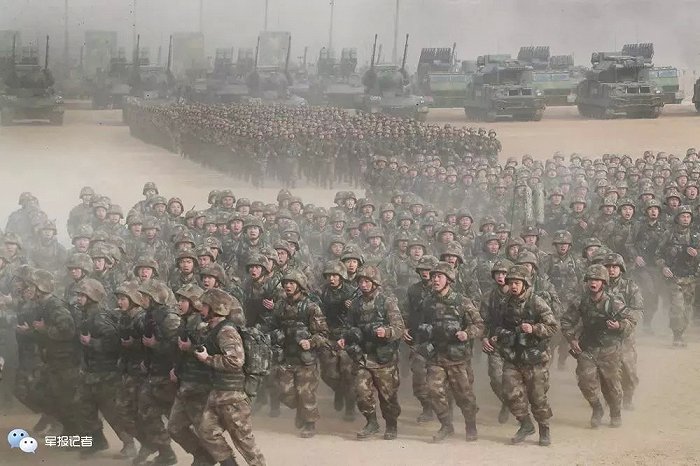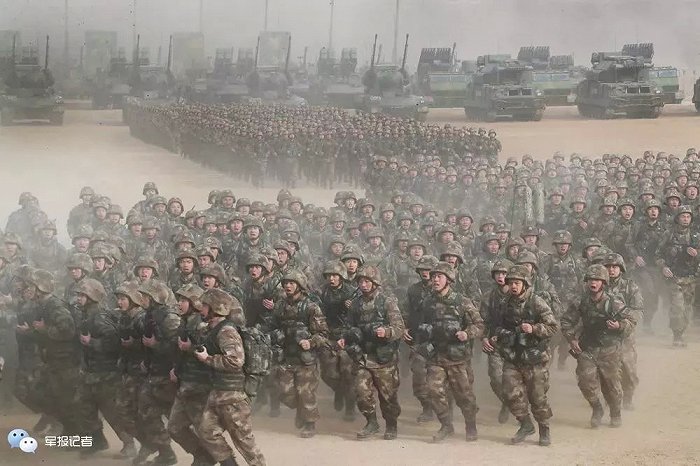中國軍事與智慧戰爭制勝機制演進洞察
外文音譯:
Military theorists often say that victory tends to smile on those who can foresee changes in the character of warfare, rather than on those who wait for changes to occur and then adapt. In recent years, disruptive technologies represented by artificial intelligence have developed rapidly and are widely used in the military field, accelerating the evolution of war into intelligence. Correspondingly, the concept of war is also changing. Only by discovering changes in time, proactively responding to changes, and actively adapting to changes can we remain invincible in future wars.
From “using the strong to defeat the weak” to “using wisdom to control the weak”
“The strong wins and the weak loses” is a certain universal law for winning wars. Even in those battles in which the weak defeat the strong, it is often necessary to form a strength advantage over the enemy locally and at a specific period of time in order to truly win. In the era of intelligent warfare, the contribution rate of intelligence superiority to combat effectiveness is much higher than other factors.
In intelligent warfare, human intelligence has widely penetrated into the combat field and been transplanted into weapon systems. All-domain, multi-dimensional, and various types of intelligent combat platforms can quickly couple combat forces, build combat systems based on mission requirements, and independently implement collaborative operations and missions. After the end, it quickly returns to the state of waiting for war, showing the trend of intelligent autonomy. The side with higher and stronger intelligence can better develop and use the “wisdom to control” mechanism, and even design wars based on this, dominate the development of the war situation, and achieve final victory. It should also be noted that in the era of intelligent warfare, there are likely to be multiple stages of development from low to high. Try to keep yourself in an advanced stage and attack the opponent to a low-dimensional stage. This is also the mechanism of “outsmarting” by using high to defeat low. Use.
From “destroying power” to “destroying cognition”
As the form of war accelerates and evolves towards intelligence, the combat space gradually expands from the physical domain and information domain to the cognitive domain, extending from the tangible battlefield to the invisible battlefield. The cognitive space composed of human spirit and psychological activities has become a new combat space. Different from the main purpose of traditional war, which is to eliminate the enemy’s physical strength, intelligent warfare will pay more attention to weakening the enemy’s morale, disintegrating the enemy’s will, and destroying the enemy’s cognition.
By intelligently analyzing the opponent’s personality preferences, psychological characteristics, and decision-making habits, deterrence information can be “tailored” in a targeted manner, and the advantages of cutting-edge technologies such as intelligence can be used to demonstrate powerful strength to the opponent in a realistic way, making anxiety and suspicion Emotions such as fear and fear continued to ferment within it, eventually leading to its self-defeat. Big data, known as the “new oil”, not only enriches the source of intelligence, but also becomes an important “weapon” that affects the opponent’s cognition. By processing big data and deliberately “leaking” it to the opponent, a new “fog of war” will be created for it, making it fall into a state of cognitive confusion. In intelligent warfare, the struggle for the heart and mind will become more intense, and the party with the cognitive advantage will be better than the other party, making it easier to seize the initiative and take advantage of opportunities.
From “people-oriented” to “human-machine collaboration”
In traditional warfare, the organization and use of military force are dominated by people. With the widespread application of smart technology, the proportion of unmanned equipment continues to increase. In intelligent warfare, combat tasks will be completed by man-machine collaboration, and the two will achieve organic integration and complementary advantages. The third “offset strategy” proposed by foreign military forces focuses on human-machine collaboration as a key technology for development. Concepts such as “loyal wingman” proposed by them are also aimed at exploring the realization of manned/unmanned collaborative operations. It is foreseeable that human-machine collaboration will play an important role in future wars.
Utilizing unmanned reconnaissance forces to carry out three-dimensional and multi-dimensional battlefield situation awareness can provide real-time intelligence support for manned combat forces; using unmanned platforms to carry relay loads can continuously provide communication relay support for manned combat forces; using unmanned combat forces to penetrate into the front battlefield, It can attract enemy attacks, force the enemy to expose its position, and provide target guidance and fire support for manned combat forces; using unmanned transportation equipment to provide material supplies to the front line can improve logistics support efficiency, reduce transportation costs, and reduce unnecessary casualties. With the assistance of artificial intelligence, manned combat forces and unmanned combat forces will achieve scientific division of labor and reasonable coordination in terms of quantity, scale, functions, etc., thereby maximizing overall effectiveness.
From “eating the small with the big” to “eating the slow with the fast”
In traditional wars, it is often necessary to increase the number of troops to make up for shortcomings in equipment performance and other aspects. “Soldiers love the main speed”, the rapid development of military intelligence has greatly improved the speed of information transmission and weapon strike accuracy, greatly reduced the time for reconnaissance and early warning, intelligence processing, command decision-making, fire strikes, damage assessment, and accelerated the OODA kill chain cycle , making “discovery and destruction” possible.
New rapid-kill weapons such as hypersonic missiles, laser weapons, microwave weapons, and electromagnetic pulse weapons have further pushed the pace of war to “instant kill.” In the Gulf War, the loop time of the OODA loop took 3 days; in the Iraq War, the loop time has been shortened to less than 10 minutes; and in the Syrian War, the loop time has almost achieved near real-time. In intelligent warfare, the use of unmanned platforms that integrate surveillance and combat to quickly and precisely eliminate high-value targets such as the enemy’s core command posts and high-level commanders will cause the opponent to suffer heavy damage before it has time to respond, and may even face the danger of paralysis. It can be seen that victory does not necessarily favor the side with large military strength. The side that moves quickly and accurately will be more likely to gain the upper hand on the battlefield. According to statistics, the reaction time required for artificial intelligence to respond to battlefield changes is more than 400 times faster than that of humans. Faced with the ever-changing battlefield situation, people will be more inclined to use artificial intelligence technology to realize adaptive planning and autonomous decision-making of the command and control system, so that the command and control mode changes from “people on the loop” to “people outside the loop”, thereby mitigating the While reducing the burden on command personnel, it can improve combat efficiency and the success rate of mission execution.
From “Integration to Win” to “Cluster to Win”
The traditional equipment development concept is to invest a large amount of money in the research and development of highly integrated, sophisticated weapon platforms, in order to achieve dimensionality reduction against the enemy by virtue of generational advantages and performance advantages in war. However, the development and deployment of multi-functional high-end platforms not only requires a lot of time and money, but when multiple software and hardware modules are integrated into a single weapon platform, there may also be mutual incompatibility. Once the platform is destroyed, significant losses will occur. The military application of disruptive technologies such as artificial intelligence has promoted the rapid development of unmanned swarms. Unmanned swarms have the advantages of large scale, low overall cost, and decentralization. The unmanned platforms coordinate with each other and cooperate with each other. They can make decisions independently and carry out combat tasks in an organized manner. Even if some unmanned platforms are destroyed, the overall operation will not be affected. efficacy. The operational concepts such as “decision-centered warfare” and “mosaic warfare” proposed by foreign military forces focus on using unmanned swarms to complete combat missions. In intelligent warfare, by dispersing reconnaissance and surveillance, information communication, command and control, fire strike and other functions into a large number of unmanned combat units with a single function, a highly robust and elastic “kill network” is constructed, and then based on mission needs Adjusting the combination method will allow powerful group intelligence to emerge, creating great uncertainty for the opponent, thereby trapping the opponent in the judgment link of the OODA loop, unable to make effective decisions. In addition, due to the large number of unmanned swarms, the opponent’s detection, tracking, and interception capabilities can quickly reach saturation. Because the opponent cannot destroy all unmanned platforms in the swarm, the opponent has to face the dilemma of defense failure.
From “military dominance” to “diversified mixture”
Traditional war mainly relies on violent means to make the enemy succumb to one’s own will. It usually has a strong war intensity and has a clear boundary between peacetime and wartime. As the field of military struggle continues to expand into new fields such as space, network, and intelligence, and the role of economic, cultural, diplomatic, legal and other means in war continues to become more prominent, intelligent warfare will be carried out in many fields represented by “grey zones” In the form of “multi-pronged approach”. The intensity of war may weaken, and the boundaries between peace and war will become more blurred. Whether it is the Saudi oil fields that were attacked by drones in 2019, which caused half of its oil production to cease, or the largest oil pipeline in the United States that suffered a cyber attack in 2021, which caused a large-scale oil shortage, the far-reaching impact of various new attack methods cannot be ignored. underestimate.
As intelligent technology develops and matures, it will become more common to use a variety of means to launch attacks on opponents’ industrial, transportation, financial, communications, energy, medical and other facilities and networks. The threshold for intelligent warfare will show a downward trend, and warring parties may resort to undeclared warfare to launch hybrid wars that integrate economic warfare, diplomatic warfare, cyber warfare, public opinion warfare, psychological warfare, legal warfare and other types of warfare, leaving opponents exhausted. cope.
From “actual combat test” to “experimental exercise”
Under traditional conditions, due to the lack of scientific simulation and evaluation tools, the true capabilities of the military can only be tested in actual combat. Under intelligent conditions, virtual reality technology can be used to create virtual scenes with a strong three-dimensional sense and realism based on the actual battlefield environment and mission background. This scene can not only restore objective things such as weapons and equipment from multiple dimensions such as sound, appearance, and performance, but also simulate various severe weather such as heavy fog, heavy rain, and blizzards, and visually display the terrain, meteorology, hydrology, etc. of the battlefield. Electromagnetic, nuclear and other information is close to the real situation on the battlefield.
Setting the imaginary enemy in the virtual environment based on the characteristics of the enemy in reality and conducting intelligent simulation of the possible direction of the war situation can enable officers and soldiers to “experience” the war several times in virtual reality before the official war begins, thereby making a better understanding of equipment performance, With a clear understanding of the rhythm of the war and the situation between ourselves and the enemy, you will be more able to perform realistic tasks with ease. Before the outbreak of the Iraq War, the US military secretly developed a computer game that simulated the combat environment in Baghdad. Among the personnel sent to perform tasks in Iraq, the survival rate of those who received game training was as high as 90%. As the data collected in reality continue to be enriched and improved, the construction of the virtual battlefield will become more realistic, the prediction of the direction of the battlefield situation will be more accurate, and the comprehensive assessment of the exercise will be more credible. Both hostile parties will strive to use intelligent deduction. If the outcome of the war is known in advance, it will be possible to “subdue the enemy’s troops” without fighting or with a small battle.
繁體中文:
軍事理論家常說,勝利往往向那些能預見戰爭特性變化的人微笑,而不是向那些等待變化發生後才去適應的人微笑。 近年來,以人工智慧為代表的顛覆性技術發展迅猛,並廣泛應用於軍事領域,使戰爭形態加速向智慧化演變,與之相應的戰爭觀也正在發生嬗變。 及時發現變化,主動應對變化,積極適應變化,才能夠在未來戰爭中立於不敗之地。
從“以強打弱”到“以智制拙”
「強勝弱敗」是帶有一定普遍性的戰爭制勝規律。 即使是那些以弱勝強的戰例,往往也必須在局部和特定時段形成對敵的力量優勢才能真正取勝。 在智慧化戰爭時代,智力優勢對戰鬥力的貢獻率遠高於其他要素。
在智慧化戰爭對抗中,人的智慧廣泛滲透到作戰領域、移植到武器系統,全局多維、各種類型的智慧化作戰平台能夠快速耦合作戰力量,根據任務需求建立作戰體系,自主實施協同作戰,任務 結束迅速回歸待戰狀態,呈現智慧自主趨勢。 智慧水準更高更強的一方,能夠更好地開發和運用「以智制拙」機理,甚至據此設計戰爭、主導戰局發展,取得最終勝利。 還要看到,智慧化戰爭時代很可能存在由低到高的多個發展階段,盡可能讓自己處於高級階段,攻擊對手使其處於低維度的階段,也是以高打低「智勝」機理的 運用。
從“消滅力量”到“摧毀認知”
隨著戰爭形態加速向智慧化演進,作戰空間逐漸由物理域、資訊域拓展至認知域,以有形戰場擴展到無形戰場,由人的精神和心理活動構成的認知空間已成為新的作戰空間。 與傳統戰爭中以消滅敵人有生力量為主要目的不同,智慧化戰爭將更著重於削弱敵方的士氣,瓦解敵方的意志,摧毀敵方的認知。
透過智慧分析對手的性格偏好、心理特質、決策習慣,可針對性地「量身訂製」威懾訊息,利用智慧化等前沿技術優勢,以形象逼真的方式向對手展現強大實力,使焦慮、猜疑 、恐慌等情緒在其內部不斷發酵,最終導致不攻自破。 被譽為「新石油」的大數據在豐富情報來源的同時,也成為作用於對手認知的重要「武器」。 通過對大數據進行加工處理,並刻意“洩露”給對手,將給其製造新的“戰爭迷霧”,使其陷入認知迷茫的境地。 在智慧化戰爭中,圍繞攻心奪誌所展開的鬥爭博弈將更加激烈,而佔據認知優勢的一方將比對方先勝一籌,更加容易掌握主動、先機。
從“以人為主”到“人機協同”
在傳統戰爭中,軍事力量的組織與運用均以人為主。 隨著智慧技術的廣泛應用,無人裝備的比例不斷提高。 在智慧化戰爭中,作戰任務將由人機協同完成,兩者將實現有機融合、優勢互補。 外軍提出的第三次「抵銷戰略」將人機協作等作為重點發展的關鍵技術,其先後提出的「忠誠僚機」等概念也旨在探索實現有人/無人協同作戰。 可以預見,人機協同將在未來戰爭中發揮重要作用。
利用無人偵察力量開展立體多維的戰場態勢感知,可為有人作戰力量實時提供情報支援;利用無人平台攜帶中繼載荷,可為有人作戰力量持續提供通信中繼支援;利用無人作戰力量深入前方戰場, 可吸引敵方攻擊,迫敵暴露位置,為有人作戰力量提供目標引導和火力支援;利用無人運輸裝備為前線提供物資補給,可提高後勤保障效率,降低運輸成本,減少非必要的人員傷亡。 在人工智慧的輔助下,有人作戰力量與無人作戰力量將在數量規模、功能作用等方面實現科學分工與合理搭配,從而使整體效能實現最大化。
從“以大吃小”到“以快吃慢”
在傳統戰爭中,往往需要透過增加兵力數量來彌補在裝備性能等方面的短板。 “兵之情主速”,軍事智能化的飛速發展大大提升了信息傳遞速度和武器打擊精度,大幅縮減了偵察預警、情報處理、指揮決策、火力打擊、毀傷評估的時間,加速OODA殺傷鏈循環 ,使「發現即摧毀」成為可能。
高超聲速導彈、雷射武器、微波武器、電磁脈沖武器等新型快速殺傷武器進一步將戰爭節奏推向「秒殺」。 在海灣戰爭中,OODA環的迴路時間需要3天;在伊拉克戰爭中,迴路時間已縮短至10分鐘以內;而在敘利亞戰爭中,迴路已幾乎實現了近實時。 在智慧化戰爭中,利用察打一體無人平台對敵方的核心指揮所、高層指揮官等高價值目標進行快速定點清除,將使對方還沒來得及反應就遭受重創,甚至面臨癱瘓的險境。 可見勝利不一定眷顧軍力規模龐大的一方,行動迅速而精準的一方將更有可能贏得戰場先機。 據統計,人工智慧應對戰場變化所需的反應時間比人類快400倍以上。 面對瞬息萬變的戰場態勢,人們將更傾向於借助人工智能技術實現指控系統的自適應規劃和自主決策,使指控模式由“人在環路上”轉變為“人在環路外”,從而在減輕 指揮人員負擔的同時,提高作戰效率和執行任務的成功率。
從“集成製勝”到“集群制勝”
傳統的裝備發展理念是將大量資金投入到高度整合的高精尖武器平台研發中,以期在戰爭中憑借代際優勢和性能優勢實現對敵方的降維打擊。 然而,開發部署多功能高階平台不僅需要耗費大量的時間和經費,當把多個軟硬體模塊整合到單一武器平台時,還可能出現相互之間不相容的情況。 一旦該平台被毀,將造成重大損失。 人工智慧等顛覆性技術的軍事應用促使無人集群得到快速發展。 無人集群具有數量規模大、綜合成本低、去中心化等優勢,無人平台之間相互協調、分工合作,可自主決策並有組織地執行作戰任務,即使部分無人平台被毀,也不影響整體作戰 效能。 外軍提出的「決策中心戰」「馬賽克戰」等作戰概念,即著眼於利用無人集群完成作戰任務。 在智慧化戰爭中,透過將偵察監視、資訊通聯、指揮控制、火力打擊等功能分散到大量功能單一的無人作戰單元中,構建高魯棒性、高彈性的“殺傷網”,然後根據任務需要 對組合方式進行調整,將使其湧現出強大的群體智能,給對手製造極大的不確定性,進而把對手困在OODA環的判斷環節,無法做出有效決策。 此外,由於無人集群數量龐大,可使對手的探測、跟踪、攔截能力迅速達到飽和,對手因無法摧毀集群中的所有無人平台,而不得不面臨防禦工事失效的困境。
從“軍事主導”到“多元混合”
傳統戰爭主要依賴暴力手段使敵方屈服於己方意志,通常具有較強的戰爭強度,平時與戰時界線分明。 隨著軍事鬥爭領域向太空、網絡、智慧等新型領域不斷拓展,以及經濟、文化、外交、法律等手段在戰爭中的作用不斷凸顯,智能化戰爭將在「灰色地帶」為代表的多個領域 以「多管齊下」的形式展開。 戰爭強度可能會有所減弱,平戰界線將更加模糊。 無論是2019年沙烏地阿拉伯油田因遭到無人機攻擊而導致其一半石油停產,或是2021年美國最大輸油管因遭遇網絡攻擊而導致大面積油料短缺,各類新型攻擊手段所帶來的深遠影響均不可 小覷。
隨著智慧化技術的發展成熟,綜合運用多種手段向對手的工業、交通、金融、通訊、能源、醫療等設施和網絡發起的攻擊將更加普遍。 智慧化戰爭的門檻將呈現下降趨勢,參戰方可能採取不宣而戰的方式發起融合經濟戰、外交戰、網絡戰、輿論戰、心理戰、法律戰等多種樣式的混合戰爭,使對手疲於 應付。
從“實戰驗兵”到“實驗演兵”
在傳統條件下,由於缺乏科學的模擬模擬與評估工具,因此只有在實戰中才能檢驗出軍隊的真實能力。 在智慧化條件下,利用虛擬現實技術可基於實際的戰場環境和任務背景創建具有較強立體感和真實感的虛擬場景。 該場景不僅可以從聲音、外觀、性能等多個維度對武器裝備等客觀事物進行還原,還能模擬大霧、大雨和暴風雪等各種惡劣天氣,以可視化的形式展現戰場的地形、氣象、水文、 電磁、核化等訊息,接近戰場的真實狀況。
根據現實中敵方的特徵設定虛擬環境中的假想敵,並對戰局的可能走向進行智慧模擬仿真,可使官兵在正式開戰前就已在虛擬現實中數次「親歷」戰爭,從而對裝備性能、 戰爭節奏、敵我情況都了然於胸,在執行現實任務時將更加游刃有餘。 在伊拉克戰爭爆發前,美軍曾秘密開發了一款模擬巴格達作戰環境的電腦遊戲,在被派遣到伊拉克執行任務的人員中,接受過遊戲訓練的人員生存率高達90%。 隨著現實中收集到的數據不斷豐富完善,虛擬戰場的搭建將更加逼真,對戰場態勢的走向預測將更加準確,關於演習的綜合評估將更加可信,敵對雙方都力圖通過智能推演即可 預先獲知戰爭結果,將可能出現不戰或小戰就「屈人之兵」的情況。
謝愷 張東潤 梁小平
來源:解放軍報 作者:謝愷 張東潤 梁小平 責任編輯:葉夢圓 2022-04-26 06:00:00
中國國防部原文資源:http://www.mod.gov.cn/gfbw/wzll/yw_214068/4909826.html





